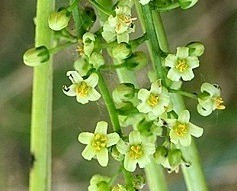"Atlantic poison oak "
(Toxicodendron pubescens)

Description
Toxicodendron pubescens (syn. Rhus pubescens), commonly known as Atlantic poison oak, is an upright shrub that can grow to 1 m (3 ft) tall. Its leaves are 15 cm (6 in) long, alternate, with three leaflets on each. The leaflets are usually hairy and are variable in size and shape, but most often resemble white oak leaves; they usually turn yellow or orange in autumn. The fruit is small, round, and yellowish or greenish. It is not closely related to true oaks. This species is native to the Southeastern United States from Virginia. westward to Texas and Oklahoma. Atlantic poison oak can be found growing in forests, thickets, and dry, sandy fields. All parts of this plant contain urushiol, which can cause severe dermatitis in sensitive individuals. The risk of exposure may be reduced by learning to recognize and avoid this species and wearing clothing that covers the legs and arms. Contaminated clothing should be laundered before subsequent handling or use. Effects of poison oak are similar to those of poison ivy. It first causes severe itching, evolves into inflammation, non-colored bumps, and then blistering when scratched. Toxicodendron is a genus of flowering plants in the sumac family, Anacardiaceae. It contains trees, shrubs and woody vines, including poison ivy, poison oak, and the lacquer tree. All members of the genus produce the skin-irritating oil urushiol, which can cause a severe allergic reaction. The generic name is derived from the Greek words (toxikos), meaning "poison," and (dendron), meaning "tree". The best known members of the genus in North America are poison ivy (T. radicans), practically ubiquitous throughout most of eastern North America, and western poison oak (T. diversilobum), similarly ubiquitous throughout much of the western part of the continent. The genus is a member of the Rhus complex, and has at various times been categorized as being either its own genus or a sub-genus of Rhus. There is evidence which points to keeping Toxicodendron as a separate monophyletic genus, but researchers have stated that the Toxicodendron and Rhus groups are complex and require more study to be fully understood.
Taxonomic tree:







